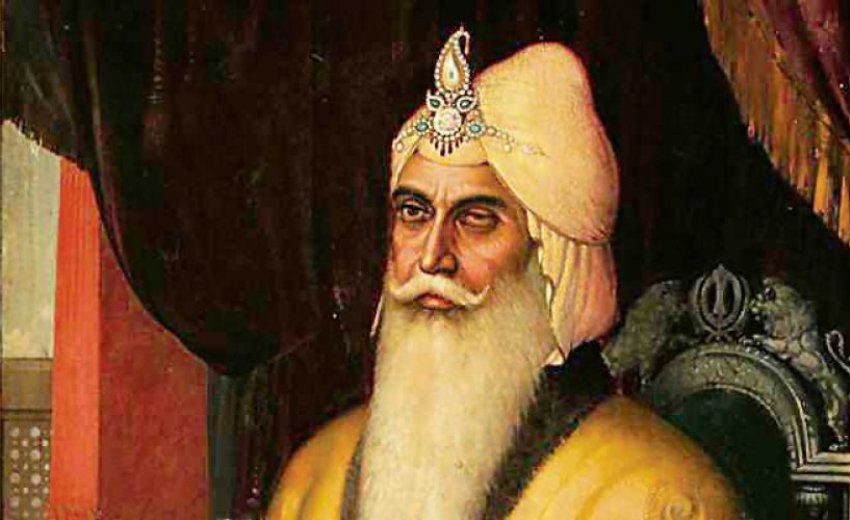A life-size bronze statue of Maharaja Ranjit Singh, the 19th-century founder of the Sikh kingdom of Punjab, was unveiled in the historic Lahore Fort to thunderous applause from history aficionados on 27 June 2019. The Lahore Walled City Authority (LWCA) unveiled the statue in a graceful ceremony that was attended by Punjab’s minister for tourism, Raja Yasir Humayun, as the guest of honor.
The colossal sculpture was unveiled to commemorate the 180th death anniversary of Maharaja Ranjit Singh, who ruled Punjab for almost four decades. The statue is installed in front of the Mai Jindian Haveli in the Lahore Fort, close to the building that houses both the Maharaja's samadhi and the Gurudwara Dera Sahib of Guru Arjun Dev. The haveli, named after Ranjit Singh's youngest queen, houses a permanent exhibition of Sikh artifacts in the Sikh Gallery.
The tall statue of the Maharaja, made of cold bronze, shows the regal Sikh emperor riding Kahar Bahar, his favorite Arabic horse, wielding a sword in hand, in complete Sikh attire Bobby Singh Bansal, a UK-based historian, and Sikh Khalsa (SK) Foundation head sponsored the sculpture, which took approximately eight months to create. It was under the supervision of Faqir Syed Saifuddin, Director of Lahore's famous private Faqir Khana Museum. It weighs approximately 250-330 kilograms and is made from 85 percent bronze, 5 percent tin, 5 percent lead, and 5 percent zinc.
When compared to other Maharaja Ranjit Singh statues in this region, the sculpture is unparalleled in its craftsmanship and is finished in fiber cold bronze material. The statue was sculpted by three artist-sculptors from Lahore’s National College of Art and Naqsh School of Art under Saifuddin's direction.
“The statue has been made using the cold bronze technique. It took nearly eight months to make and is the most beautiful statue of Ranjit Singh to be made, even more than the ones in Amritsar and Delhi,” quoted Faqir Syed Saifuddin.
Kamran Lashairi, Director-General of the WCLA said, “As you know, religious tourism is one of the main themes of our government. Kartarpur Sahib and Nankana Sahib have got more attention from this government. The Ranjit Singh statue is in line with the government’s focus on religious tourism, particularly Sikh religious tourism. There is a great deal of Sikh heritage in and around Lahore Fort, including the Ranjit Singh samadhi, and the Gurudwara Dera Sahib. We also have a Sikh Gallery inside the fort now.”
Maharaja Ranjit Singh- Founder of the Sikh Empire
The Lion of the Punjab or Sher-e-Punjab, Maharaja Ranjit Singh, was born in Gujranwala (now in Pakistan) on November 13, 1780. Born Buddh Singh, he rose to the throne in April 1801 and governed his kingdom for 38 years. Historians commonly regard him as one of the greatest Sikh kings of all time, pointing out that he successfully defeated the army of Shah Zaman, a ruler of the Ahmad Shah Abdali dynasty, to establish his rule in 1797 and 1798.In 1799, he also captured Lahore, which became the capital of his Sikh empire in 1801. Punjab's Sikh kingdom was founded by this great ruler and warrior.
He was the first Indian in a millennium to reverse the tide of invasion back into the homelands of India's traditional conquerors, the Pashtuns (Afghans). He controlled the area from the Khyber Pass in the northwest to the Sutlej River in the east, and from Kashmir, the northernmost part of the Indian subcontinent, southward to the Thar (Great Indian) Desert. The Punjab state is the only one to have defeated Afghanistan.
Known to be the finest warrior of his time, he hired European mercenaries to train his army because he distrusted the British. The Sikh Khalsa Army, his first modern Indian army, helped prevent the British from colonizing Punjab during his lifetime.
The installation of the statue honors and pays homage to Maharaja Ranjit Singh, a son of the soil of Punjab, while also promoting religious tourism and drawing Sikhs and admirers of Punjab from around the globe.
